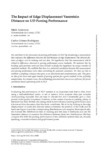The Impact of Edge Displacement Vaserstein Distance on UD Parsing Performance

Use este enlace para citar
http://hdl.handle.net/2183/32322
A non ser que se indique outra cousa, a licenza do ítem descríbese como Atribución-NoComercial-SinDerivadas 4.0 Internacional
Coleccións
- GI-LYS - Artigos [51]
- OpenAIRE [376]
Metadatos
Mostrar o rexistro completo do ítemTítulo
The Impact of Edge Displacement Vaserstein Distance on UD Parsing PerformanceData
2022Cita bibliográfica
Mark Anderson, Carlos Gómez-Rodríguez; The Impact of Edge Displacement Vaserstein Distance on UD Parsing Performance. Computational Linguistics 2022; 48 (3): 517–554. doi: https://doi.org/10.1162/coli_a_00440
Resumo
[Abstract] We contribute to the discussion on parsing performance in NLP by introducing a measurement that evaluates the differences between the distributions of edge displacement (the directed distance of edges) seen in training and test data. We hypothesize that this measurement will be related to differences observed in parsing performance across treebanks. We motivate this by building upon previous work and then attempt to falsify this hypothesis by using a number of statistical methods. We establish that there is a statistical correlation between this measurement and parsing performance even when controlling for potential covariants. We then use this to establish a sampling technique that gives us an adversarial and complementary split. This gives an idea of the lower and upper bounds of parsing systems for a given treebank in lieu of freshly sampled data. In a broader sense, the methodology presented here can act as a reference for future correlation-based exploratory work in NLP.
Palabras chave
Parsing performance
Test data
NLP systems
Test data
NLP systems
Versión do editor
Dereitos
Atribución-NoComercial-SinDerivadas 4.0 Internacional
ISSN
1530-9312






